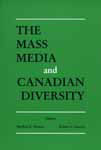
| Home News Releases | Calendar Contact |
Sources Bookshelf

Mass Media and Canadian Diversity
Nancoo, Stephen E.; Nancoo, Robert S.
Publisher: Canadian Educators' Press, Mississauga, CanadaYear Published: 1997
Pages: 288pp ISBN: 1-896191-04-5
Library of Congress Number: P94.5M552C35 1996 Dewey: 302.23'08'693
Please see our media profile in Sources:
Sources Select Resources
It has become something of a truism - a key distinction between Canada and our southern neighbour being our belief in a cultural mosaic rather than a melting pot. Of course cultural critics and folks on the street have all used the past two decades to critique the Canadian model of multiculturalism and its much touted success. The Mass Media and Canadian Diversity is no different. It holds Canadian media portrayals of visible and cultural minorities up to scrutiny, and finds them much wanting.
In a collection of academic and sociological pieces, Nancoo and Nancoo present disturbing historical portraits ("The Invisible Mosaic: Women, Ethnicity and The Vancouver Press, 1905-1976, by Doreen Indra) and close-up case studies of events such as the Kahnesetake confrontations between First Nations and the Canadian and Quebec governments ("Rights and Warriors: First Nations, Media and Identity" by Gail Guthrie Valaskakis). Not every approach is equally successful for the lay reader. Certainly Valaskakis insightful assessment of the Mohawk Warrior phenomenon and its portrayal in the media makes compelling reading. Pieces such as "Female Stereotyping in Advertising" (Robert G. Wyckham) and "The Distorted Mirror: Images of Visible Minority Women in Canadian Print Advertising" (Robert M. MacGregor) feel stilted and top heavy with data analysis to the reader hoping for a sexy cultural critique. On the other hand, a clear eyed picture of exactly what is being portrayed in the media is necessary for complete understanding.
In Part IV, the attention is turned to minority controlled media and the vehicle for expression it provides. Again, the lay reader is much more likely to be drawn in by the articles not based on study results, as they contain far more profiles of specific instances and success stories rather than statistical breakdowns of household use of media outlets be language. J.B. Minore and M.E. Hill's "Native Language Broadcasting: An Experiment in Empowerment" is particularly able to capture the power which a self-directed media can have on a disenfranchised group.
In the final section, the two editors take it upon themselves to peer into the future of representations of diversity by the media. They point to the increasing diversity of the media itself as a key factor. As the monolithic media is splintered into thousands of niche publications and outlets, representing diversity begins to take on a whole new shape. Diversity is at once further celebrated and further hidden.
All in all, The Mass Media and Canadian Diversity is an excellent collections of very distinctly Canadian focused articles - although the title is somewhat misleading. By examining not only portrayals of minority populations in the mass media, but cultural production emanating from within minority linguistic and cultural groups, Nancoo and Nancoo have painted a portrait of a country at once welcoming difference and distinctly uncomfortable with it. Although most suitable for the student able to make sense of tables of statistics, The Mass Media and Canadian Diversity has a few gems worth reading by any Canadian.
[Review by Kirsten Cowan]
Subject Headings
© Sources 2023. The information provided is copyright and may not be reproduced in any form or by any means (whether electronic, mechanical or photographic), or stored in an electronic retrieval system, without written permission of the publisher.